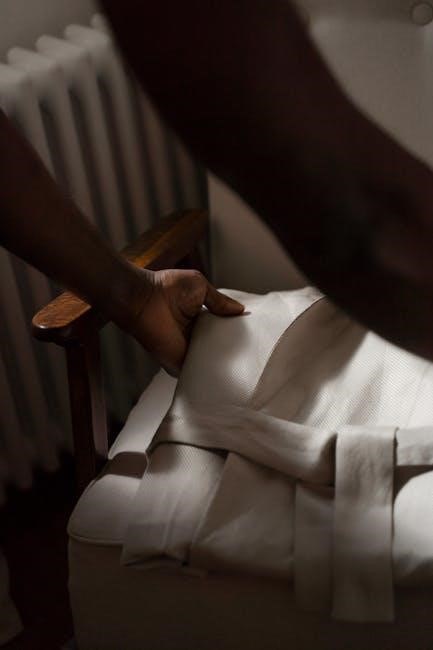A proper baseball warm-up routine is essential for preparing players physically and mentally; It combines light jogging, dynamic stretching, and throwing drills to enhance performance and prevent injuries.
Importance of Warm-Up in Baseball
A baseball warm-up is crucial for preparing the body and mind for physical demands. It increases blood flow and muscle temperature, reducing injury risks and enhancing flexibility. A proper warm-up improves strength, coordination, and reaction times, ensuring optimal performance. It also prepares the nervous system for explosive movements, such as sprinting and throwing. Additionally, it mentally readies players, fostering focus and teamwork. Neglecting a warm-up can lead to poor performance and higher injury chances. Thus, a structured warm-up is essential for peak performance and long-term player health.
Objective of a Baseball Warm-Up Routine
The primary objective of a baseball warm-up routine is to prepare the body for physical activity, enhancing performance while reducing injury risk. It aims to raise heart rate and muscle temperature, improving flexibility, strength, and coordination. The routine also focuses on activating specific muscle groups used in baseball, such as the legs, core, and shoulders. Additionally, it helps players transition mentally from rest to competition, ensuring they are focused and ready to perform at their best. A well-structured warm-up lays the foundation for a successful practice or game, benefiting both individual players and the team as a whole.

Components of an Effective Baseball Warm-Up Routine
A well-rounded baseball warm-up includes general body warm-up, dynamic stretching, baseball-specific drills, and throwing exercises. These components prepare athletes for optimal performance and injury prevention.
General Body Warm-Up
The general body warm-up is the foundation of a baseball warm-up routine. It typically begins with light jogging for 10 minutes to increase heart rate and blood flow. This phase prepares the muscles for more intense movements. Players may also engage in high knees, butt kicks, or walking lunges to activate the lower body. Arm circles and torso twists are often included to loosen the upper body. The goal is to raise body temperature and stimulate the neuromuscular system, ensuring athletes are ready for dynamic stretching and sport-specific drills. This step is crucial for injury prevention and performance enhancement.
Dynamic Stretching Exercises
Dynamic stretching exercises are a critical component of a baseball warm-up routine. These movements involve active muscle engagement and mimic baseball-specific actions, such as swinging, throwing, and running. Examples include arm circles, leg swings, and torso twists, which help increase blood flow and flexibility. Players often perform high knees, butt kicks, and lunges to activate the lower body. Dynamic stretching improves range of motion and reduces muscle stiffness, preparing the body for explosive movements like sprinting and changing direction. This phase transitions the body from a general warm-up to more intense, sport-specific activities, enhancing performance and reducing injury risk. Proper form is essential to maximize benefits.
Baseball-Specific Drills
Baseball-specific drills simulate game-like scenarios, preparing players for the demands of the sport. These drills include fielding ground balls, catching fly balls, and batting practice with soft toss or tee work. Players also perform agility ladder drills to improve footwork and quick changes of direction. Additionally, infield and outfield drills focus on throwing accuracy and efficiency. These exercises not only enhance technical skills but also build muscle memory, ensuring players are game-ready. By replicating actual game situations, baseball-specific drills bridge the gap between warm-up and competition, making the transition seamless and effective for optimal performance on the field.
Throwing Exercises
Throwing exercises are a critical component of the baseball warm-up, designed to gradually prepare the arm for pitching or fielding. Players begin with short, controlled tosses to activate the shoulder and elbow joints. Progressing to longer distances, they incorporate different angles and speeds, simulating game-like throws. Emphasizing proper mechanics ensures injury prevention and improves accuracy. These exercises enhance arm strength, flexibility, and coordination, building a foundation for peak performance during the game. By methodically increasing intensity, throwing drills ensure the arm is fully prepared for the demands of competitive play, reducing the risk of strain or fatigue.

Step-by-Step Guide to the Baseball Warm-Up Routine
A structured warm-up begins with light jogging, followed by dynamic stretching, then throwing drills, and concludes with a cool-down to ensure optimal preparation and injury prevention.

Light Jogging (10 minutes)
Light jogging is the initial phase of the warm-up, designed to gradually increase heart rate and blood flow. Players jog around the field or a designated area for 10 minutes. This gentle cardio exercise prepares the muscles for more intense movements; It’s essential to keep the pace steady and avoid overexertion. Coaching staff should ensure all players participate actively, setting the foundation for the dynamic stretches and drills to follow. Proper hydration and comfort should be monitored during this phase to maintain energy levels throughout the routine.
Dynamic Stretching (10-15 minutes)
Dynamic stretching is a critical phase that follows light jogging, focusing on active movements to improve flexibility and mobility. Players perform exercises such as arm circles, leg swings, and torso twists. These movements mimic baseball actions, preparing the muscles for game-specific motions. Dynamic stretching increases blood flow to the extremities and enhances range of motion, reducing the risk of injury. Coaches often lead this phase, ensuring proper technique and participation. The dynamic stretches transition smoothly into the next phase of the warm-up, building intensity and readiness for more demanding drills.
Throwing Drills (10-15 minutes)
Throwing drills are a vital component of the warm-up, designed to prepare the arm for pitching and fielding. Players begin with short, gentle tosses, gradually increasing distance and intensity. This phase focuses on improving accuracy, arm strength, and proper throwing mechanics. Coaches often incorporate partner drills, where players pair up to practice throws from various angles. The goal is to enhance arm mobility and endurance while reducing the risk of injury. Proper technique is emphasized to ensure players develop consistent and effective throwing skills, transitioning seamlessly into game-ready condition.
Cool Down and Final Stretching
The cool-down phase is essential for gradually lowering the body’s heart rate and temperature after intense activity. It involves static stretching to improve flexibility and reduce muscle tension. Players focus on stretching major muscle groups, such as hamstrings, quadriceps, and shoulders, holding each stretch for 20-30 seconds. This step helps prevent soreness and promotes recovery. Coaches guide the team through a series of controlled movements, ensuring proper form to maximize benefits; The final stretching routine concludes the warm-up, leaving players relaxed and prepared for the upcoming game or practice.
Benefits of a Proper Baseball Warm-Up Routine
A proper warm-up enhances overall athleticism and readiness, prevents injuries, and boosts flexibility. It prepares the body for physical demands, ensuring optimal performance.
Injury Prevention
A proper baseball warm-up routine significantly reduces the risk of injuries by gradually increasing blood flow and preparing muscles for physical activity. Dynamic stretching and light jogging prepare the body, while targeted exercises focus on areas prone to strain, such as hamstrings and shoulders. This preparation minimizes the likelihood of common baseball injuries, ensuring players can perform safely and effectively throughout the game or practice. A consistent warm-up routine is essential for maintaining long-term player health and avoiding setbacks.
Improved Performance
A well-structured warm-up routine enhances baseball performance by increasing flexibility, strength, and coordination. Dynamic stretching improves range of motion, allowing for more powerful swings and throws. Throwing drills and light jogging boost cardiovascular endurance and muscle readiness, enabling players to react faster and maintain energy levels throughout the game. Additionally, a proper warm-up sharpens focus and mental preparedness, crucial for strategic decision-making on the field. These factors combined ensure peak performance, making a warm-up routine a cornerstone of success in baseball.
Enhanced Flexibility and Mobility
A proper baseball warm-up routine significantly improves flexibility and mobility by incorporating dynamic stretches and movements. Exercises like arm circles, leg swings, and torso twists target key muscle groups used in baseball, such as the hamstrings, shoulders, and hips. Increased blood flow and reduced muscle stiffness from these exercises enhance movement efficiency, allowing players to perform baseball-specific actions like batting, throwing, and fielding with greater ease and precision. Consistent warm-up routines also promote long-term flexibility, enabling athletes to maintain optimal range of motion throughout the season.
Sample Baseball Warm-Up Routine PDF
A Sample Baseball Warm-Up Routine PDF provides a structured outline of exercises, including jogging, dynamic stretches, and throwing drills, to ensure a consistent pre-game preparation.
Structure of the PDF
The PDF typically begins with an introduction to the warm-up routine, followed by a detailed step-by-step guide. It includes sections for general body warm-up, dynamic stretching, baseball-specific drills, and throwing exercises. Visual diagrams and images are often provided to demonstrate proper form and technique. The PDF may also include a section for cool-down stretches and nutritional advice. It is designed to be user-friendly, with clear headings, bullet points, and concise instructions. Many PDFs allow for customization, enabling coaches or players to tailor the routine to specific needs or skill levels. This structure ensures a comprehensive and organized approach to pre-game preparation.
Key Elements to Include
A baseball warm-up routine PDF should include dynamic stretching, light jogging, and throwing drills. Dynamic stretches like arm circles and leg swings prepare muscles for activity. Jogging increases heart rate and blood flow, while throwing drills improve accuracy and arm strength. The PDF should also cover cool-down stretches to prevent soreness. Including visual guides and step-by-step instructions ensures proper technique. A timeline helps manage the 30-minute routine, and customization options allow tailoring to individual or team needs. Proper sequencing of exercises is crucial to maximize effectiveness and safety. These elements ensure a comprehensive and effective warm-up program.
How to Create a Custom Warm-Up Routine

To create a custom baseball warm-up routine, assess player needs and goals. Start with light jogging to raise heart rates, followed by dynamic stretches targeting major muscle groups. Incorporate sport-specific drills like throwing and fielding to mimic game actions. Allow flexibility for individual adjustments while maintaining a structured timeline. Coaches should demonstrate proper techniques and monitor progress. Players should communicate feedback to refine the routine. Regularly review and update the warm-up to ensure it remains effective and relevant. This tailored approach ensures optimal preparation and injury prevention for each athlete. Consistency and adaptability are key to success.

Coaches’ Role in Implementing the Warm-Up Routine
Coaches lead the warm-up, demonstrate techniques, and monitor player progress. They ensure compliance, provide feedback, and adapt routines to meet team and individual needs effectively.
Leading the Warm-Up
Coaches should start by leading the warm-up, ensuring all players follow the routine; They begin with light jogging to increase blood flow and body temperature. Next, dynamic stretches are demonstrated to improve flexibility and mobility. Coaches must provide clear instructions and correct any improper techniques. They also oversee throwing drills, starting with short tosses and progressively increasing distance. Proper leadership ensures the warm-up is structured, safe, and effective, preparing players for practice or game demands. Consistency in leading helps build a disciplined and prepared team.
Monitoring Progress
Coaches must monitor players’ progress during the warm-up to ensure consistency and safety. They observe proper form and technique during drills, providing feedback to correct any mistakes. Tracking improvements helps refine the routine and address individual needs. Coaches also assess player engagement and energy levels, adjusting the pace if necessary. Monitoring ensures the warm-up remains effective and tailored to the team’s development. By observing participation and technique, coaches can identify areas needing attention and make adjustments to optimize performance and prevent injuries. Regular feedback fosters a culture of continuous improvement and accountability among players. This close oversight is vital for team success.
Ensuring Player Compliance
Coaches play a crucial role in ensuring player compliance with the warm-up routine. Leading by example and clearly communicating the importance of each exercise helps build understanding. Players should be reminded that skipping steps can lead to injuries or subpar performance. Coaches must also create an environment where players feel accountable for their preparation. By establishing a consistent routine and explaining its benefits, coaches encourage players to take ownership of their warm-up. Regular reminders and positive reinforcement can further motivate players to adhere to the routine faithfully, ensuring everyone is properly prepared for practice or games. Compliance fosters discipline and readiness.

Players’ Responsibility in the Warm-Up
Players must take accountability for their warm-up, understanding its importance and committing to each exercise. This ensures personal and team readiness for optimal performance.
Active Participation
Active participation in the warm-up is crucial for maximizing its benefits. Players should fully engage in each exercise, maintaining proper form and focus. This ensures the routine effectively prepares the body for activity. Coaches often emphasize the importance of dedication during these sessions, as lackluster effort can lead to poor performance or injury. By staying committed and attentive, players contribute to both their individual success and the team’s overall readiness. Encouraging a mindset of accountability and enthusiasm fosters a productive environment. Proper form and hydration should also be prioritized to enhance effectiveness and safety during the warm-up.
Focus on Proper Technique
Focusing on proper technique during the warm-up ensures effectiveness and safety. Coaches should demonstrate exercises clearly, while players must pay attention to form. Dynamic stretches, such as arm circles and leg swings, require controlled movements to target specific muscle groups. Throwing drills, like short toss and long toss, demand precision to build accuracy and strength. By maintaining proper mechanics, players can optimize performance and reduce injury risks. Emphasizing technique also helps develop consistency and confidence, translating to better execution during games. Prioritizing form fosters a culture of discipline and excellence within the team.
Communication with Coaches
Effective communication between players and coaches is crucial during the warm-up routine. Players should inform coaches about any physical discomfort or fatigue to adjust exercises accordingly. Coaches provide feedback on technique and progression, ensuring a safe and productive warm-up. Open dialogue helps tailor the routine to individual needs and team goals. Regular updates allow coaches to monitor progress and make necessary adjustments. Strong communication fosters a collaborative environment, ensuring players are prepared and confident for the game. It also helps maintain consistency and focus, which are vital for optimal performance and injury prevention.
Common Mistakes to Avoid
Avoid rushing the warm-up, skipping key exercises, and overexerting, as these can lead to poor preparation and increased injury risk during the game.
Rushing the Warm-Up
Rushing the warm-up is a common mistake that can lead to inadequate preparation and increased injury risk. Players often skip essential steps to save time, neglecting proper muscle activation and flexibility. This can result in poor performance and heightened susceptibility to strains or pulls during the game. A rushed warm-up fails to gradually increase heart rate and blood flow, which are critical for optimal physical readiness. Coaches and players must allocate sufficient time, ideally 30 minutes, to ensure a thorough and effective warm-up routine that prepares the body for the demands of baseball. Proper preparation is key to success and safety.
Skipping Key Exercises
Skiping essential exercises in a baseball warm-up routine can hinder preparation and increase injury risk. Many players overlook dynamic stretches or throwing drills, believing they are unnecessary. However, these exercises are vital for improving flexibility, muscle activation, and coordination. Skipping them can lead to poor performance, reduced range of motion, and heightened susceptibility to injuries. A comprehensive warm-up ensures all muscle groups are prepared for the physical demands of the game. Cutting corners may save time but compromises effectiveness and safety. Consistency and attention to detail are crucial for optimal readiness and long-term player health.
Overexertion During Warm-Up
Overexertion during a baseball warm-up can lead to fatigue, decreased performance, and increased risk of injury. Players often push too hard too early, neglecting the gradual progression needed to prepare muscles and joints. This mistake can result in strained muscles, reduced focus, and poor execution of skills. A proper warm-up should balance intensity with control, ensuring readiness without overtaxing the body. Coaches and players must emphasize moderation and adherence to the planned routine to avoid overexertion and maintain optimal preparation for the game ahead.
A well-structured baseball warm-up routine is vital for optimizing performance and reducing injury risks. By incorporating light jogging, dynamic stretching, and sport-specific drills, players prepare their bodies for the demands of the game. Consistency and proper execution are key to maximizing benefits. Coaches and players must prioritize this routine, ensuring it becomes a cornerstone of team preparation. A committed approach to warm-up enhances flexibility, mobility, and overall readiness, directly contributing to success on the field. Make it a habit to prioritize preparation for peak performance and long-term player health.
